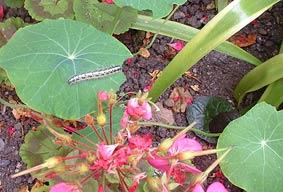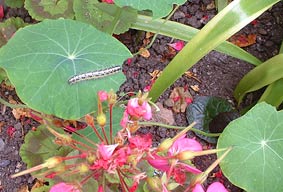One fine day

From chomping on cabbage to one day of glory. Éanna Ní Lamhna tracks the journey from caterpillar to moth
Did we ever think we'd see the day when we'd be glad to see a caterpillar crawling on our head of cabbage or cauliflower as we washed them in the sink? Long ago, it was one of the trials of preparing these vegetables for the dinner. Each leaf had to be carefully detached from the head of cabbage and any lurking caterpillars and their droppings (or indeed slugs or snails that might be there too) had to be removed by hand and the cabbage leaf soaked for a while in salty water before cooking.
Getting them out of cauliflowers was even worse until I happened upon an ingenious solution. Leave them there, boil the cauliflower as usual and when cooked, the caterpillars stand proudly on top and can be quickly plucked out. Then you just cover the cauliflower with white sauce and serve it up. Although one day, I learned the hard way the answer to the old riddle, "What's worse than finding a caterpillar on your plate?" The answer of course is, "finding half a caterpillar." And it wasn't my plate either, it was my father's!
But you never see a caterpillar on anything now, or indeed a slug or a snail. Why not? Because the vegetables are all sprayed to make sure that such wildlife cannot survive there. So you know that a cabbage with a caterpillar merrily munching on it has never been subjected to any poison – the caterpillar is a biological indicator as it were.
Caterpillars are interesting creatures. They are neither male nor female – they are purely eating machines. They have soft parts on the inside surrounded by a hard outer skin. So they cannot increase in size as they grow. As a result, when things become intolerable as a result of all their eating, they quite literally burst. Just like the Incredible Hulk's shirt, their skin bursts and they emerge from their old, too-small skin with a new thicker, hairier skin, which is often a different colour to the earlier epidermis. They burst four times in their lives and by the time they reach their fifth instar state, they never want to eat again.
They leave their food plant, climb up on a twig and turn into a chrysalis. There, meltdown takes place. They recombine their cells to become a new creature – a butterfly or a moth. These new creatures have no stomach and no guts. They cannot eat or produce droppings. They are, however, either male or female and are equipped with the respective genitalia. And as adults they meet, mate, lay eggs and die. All the food they ate as caterpillars is their fuel to keep them going as adults.
Their life span may only be a day, as in the case of the huge, glamorous, tropical butterflies. Our humbler models, including the cabbage butterfly, live longer than that – up to several weeks. They fly around looking for nice unsprayed food plants to lay their eggs on. Such cabbages are often difficult for them to find. So you might be more successful looking on your Nasturtium leaves for cabbage caterpillars if you're longing for a bit of nostalgia from the past.
